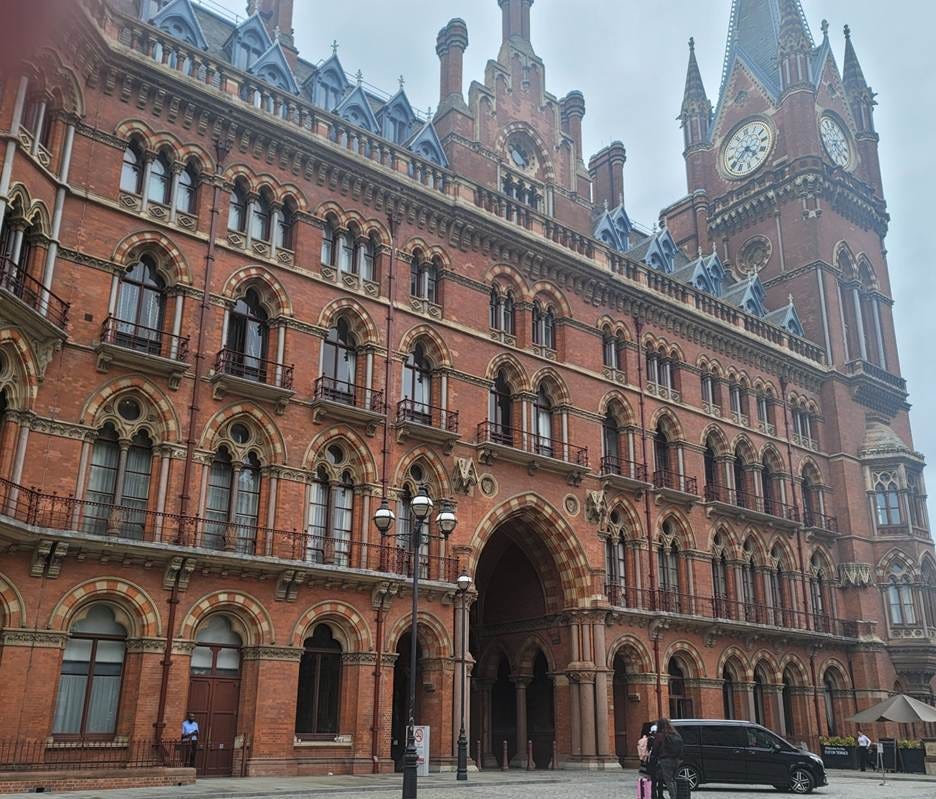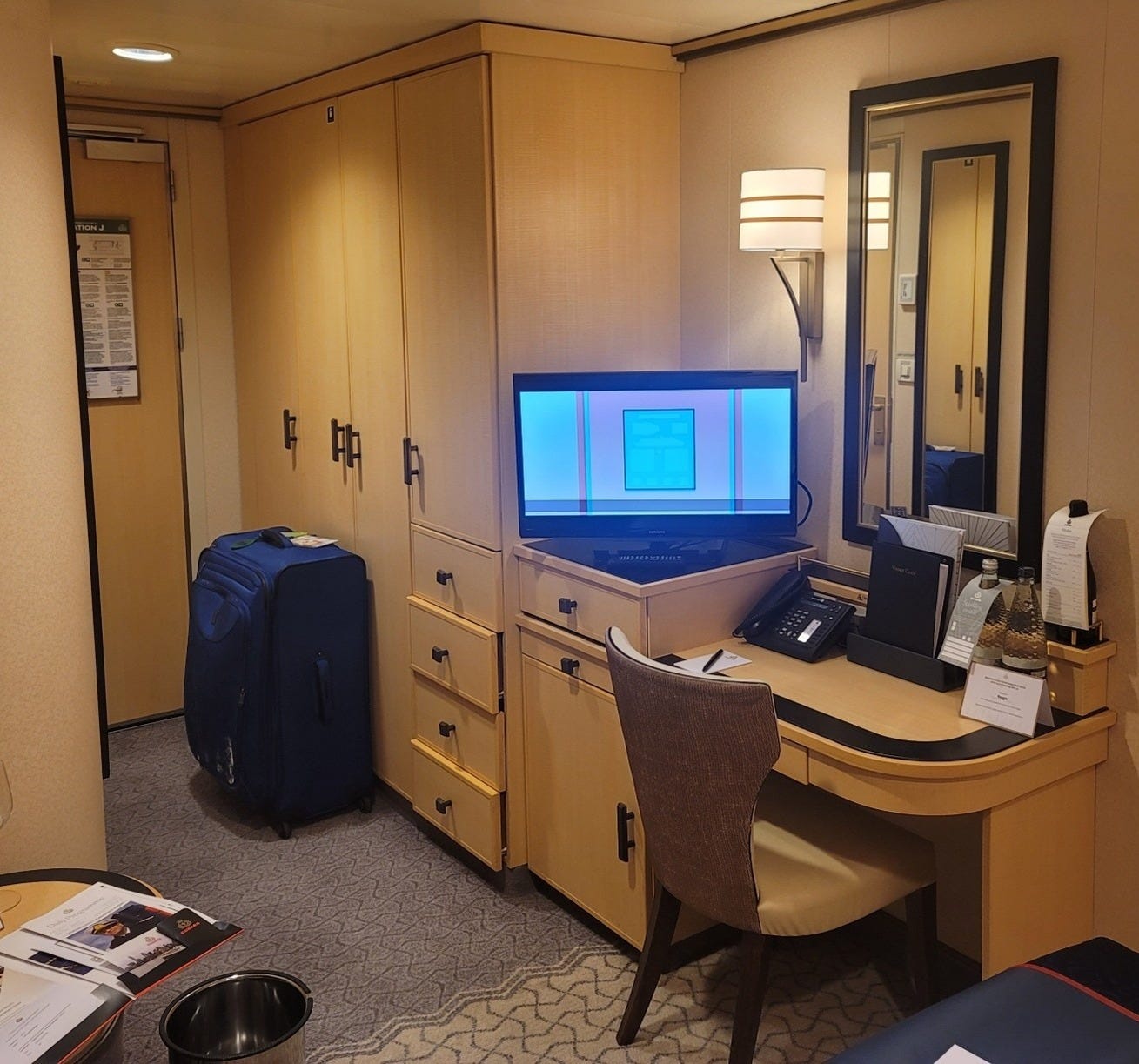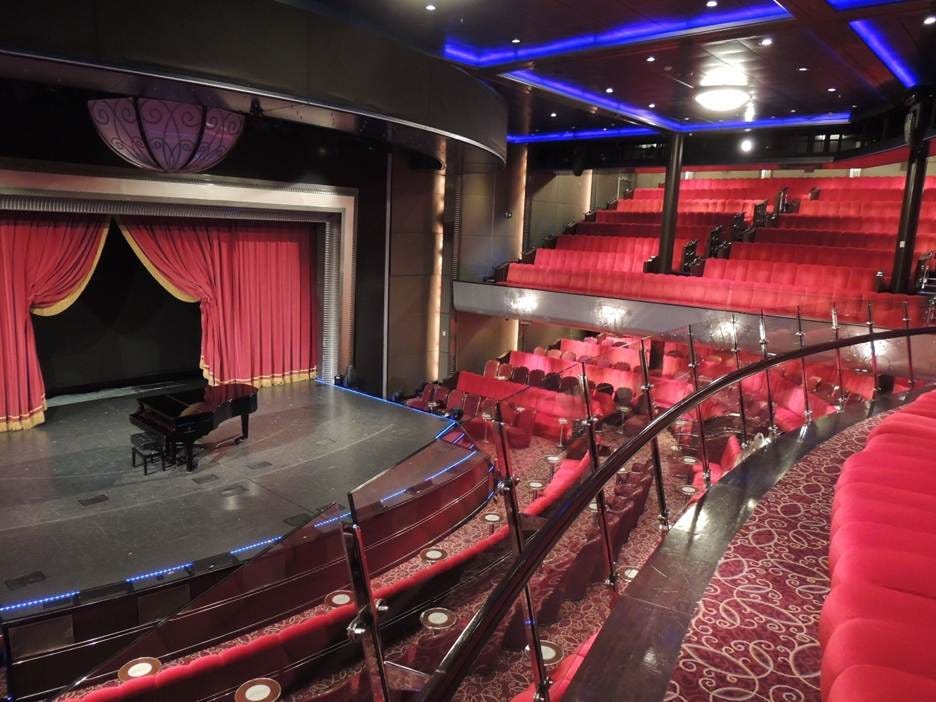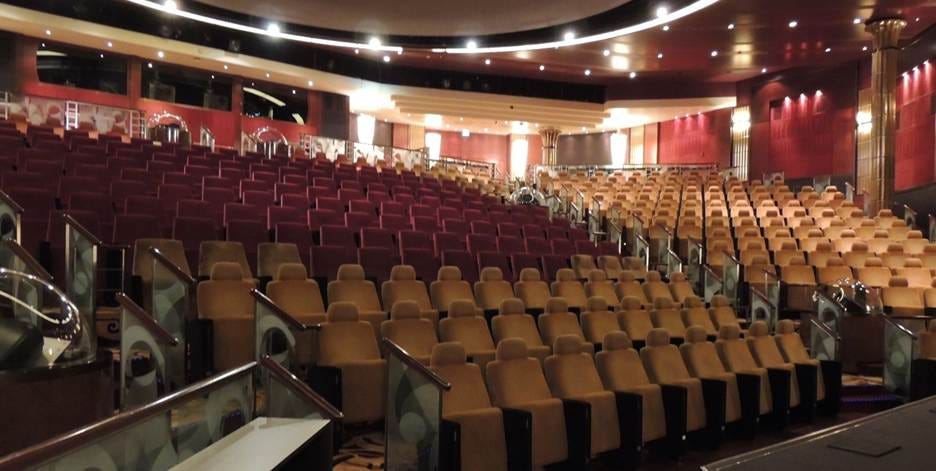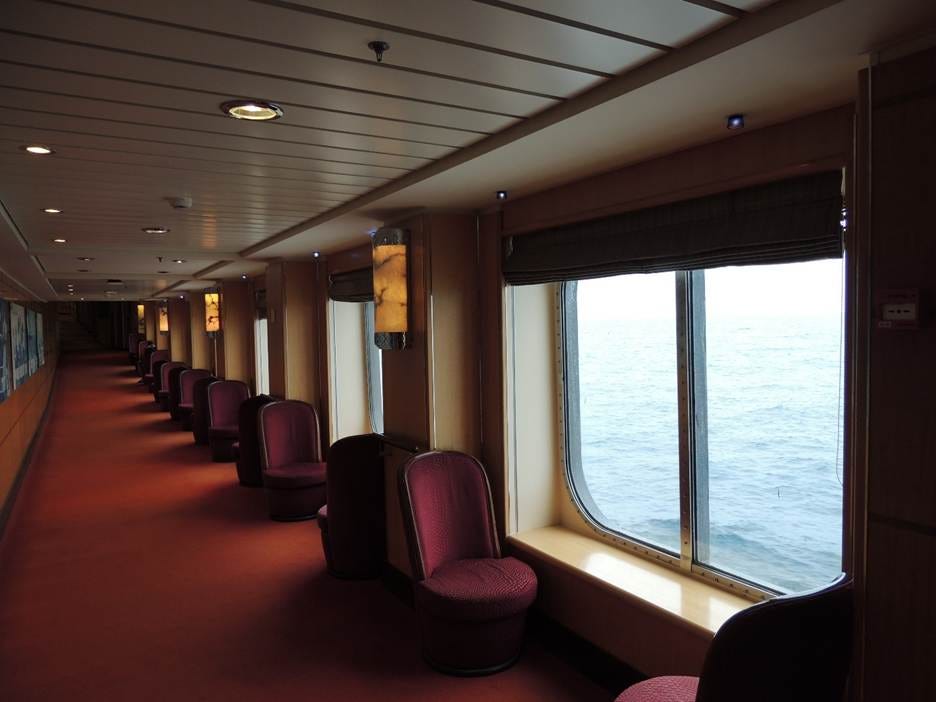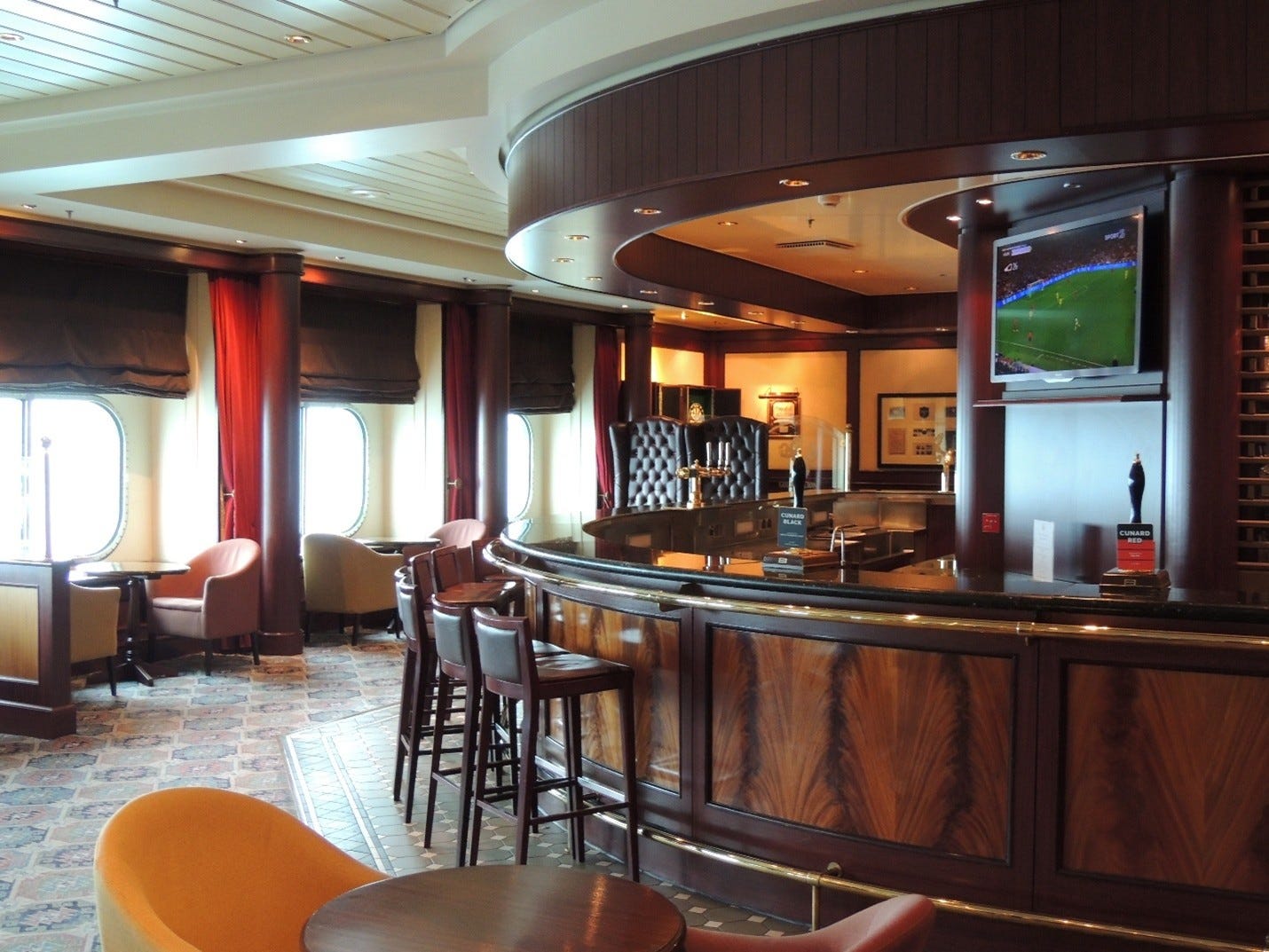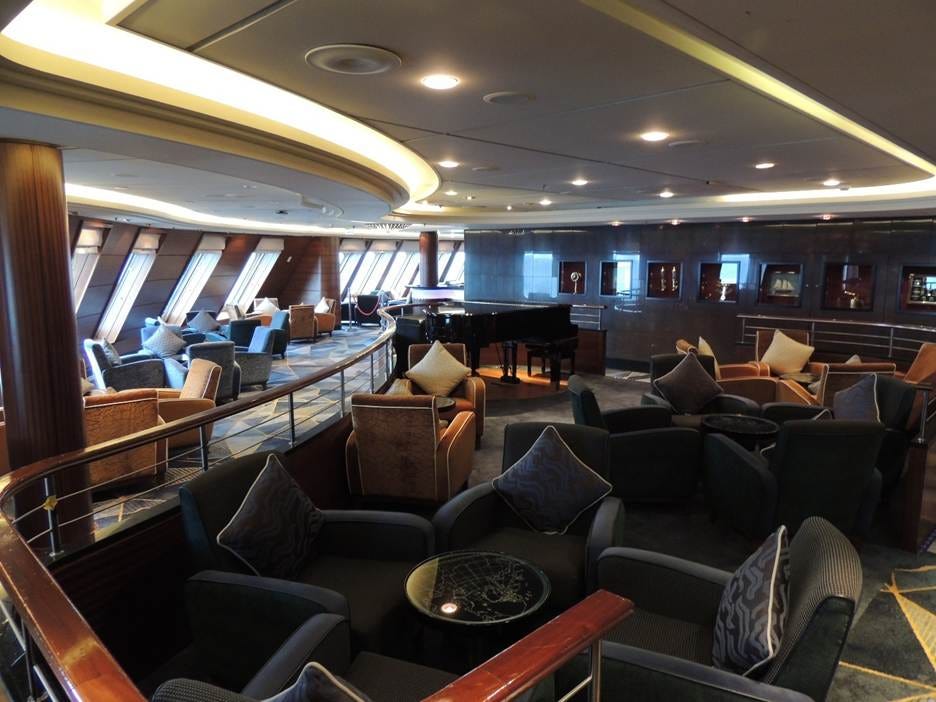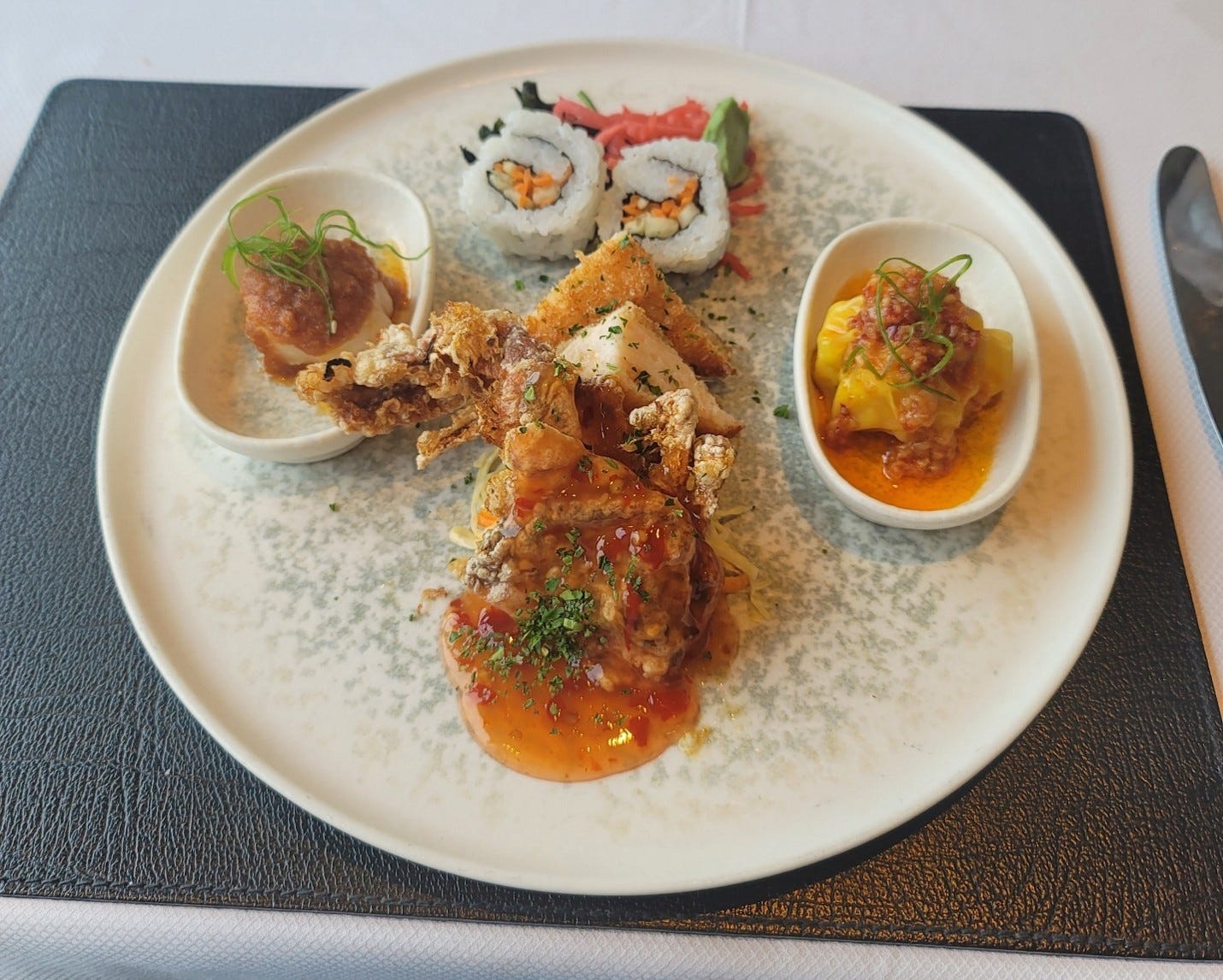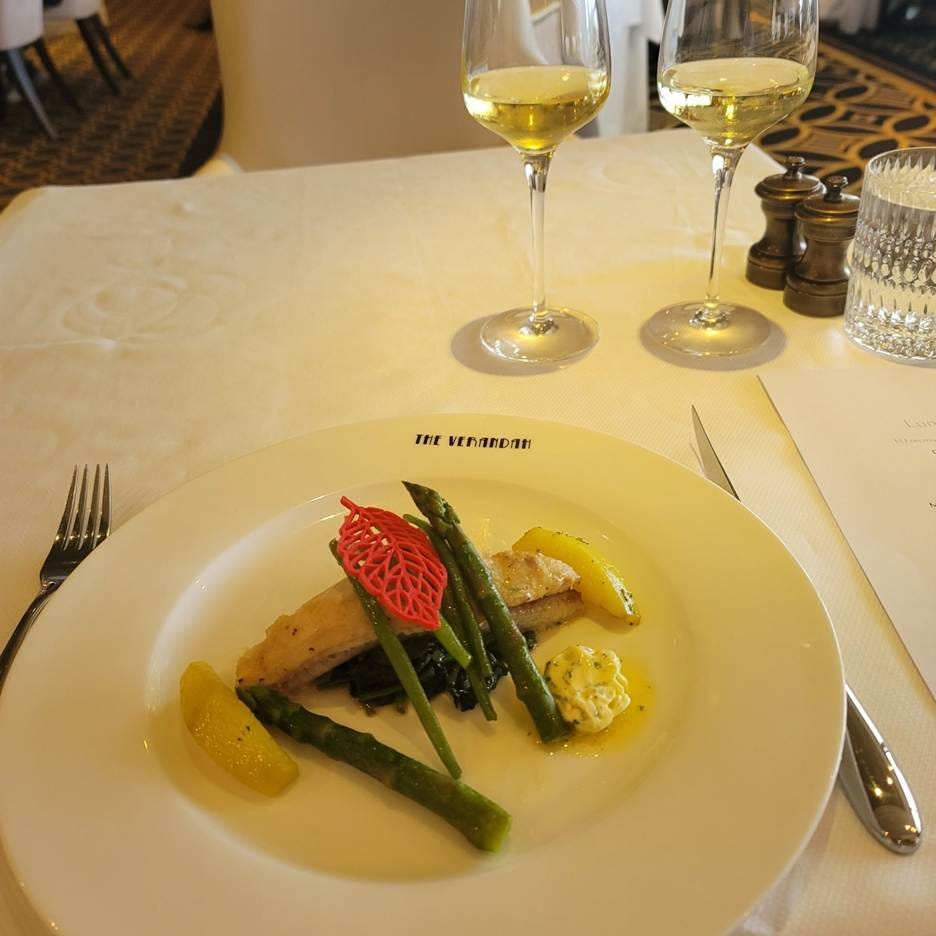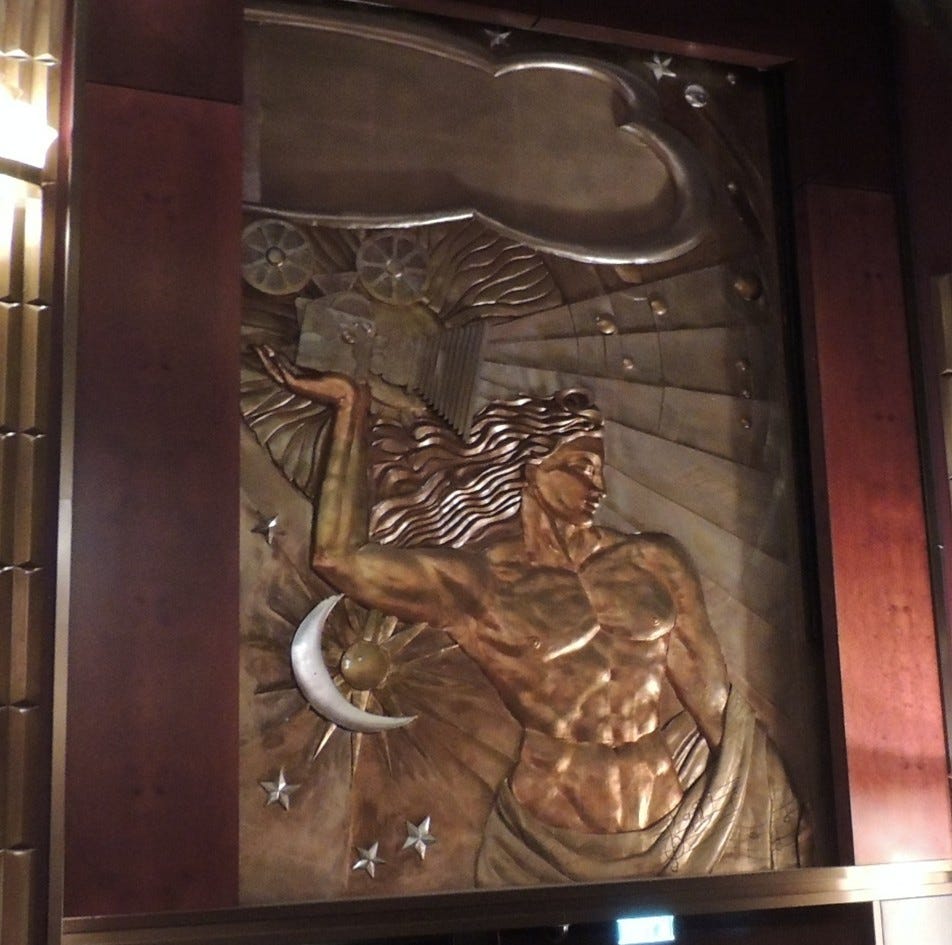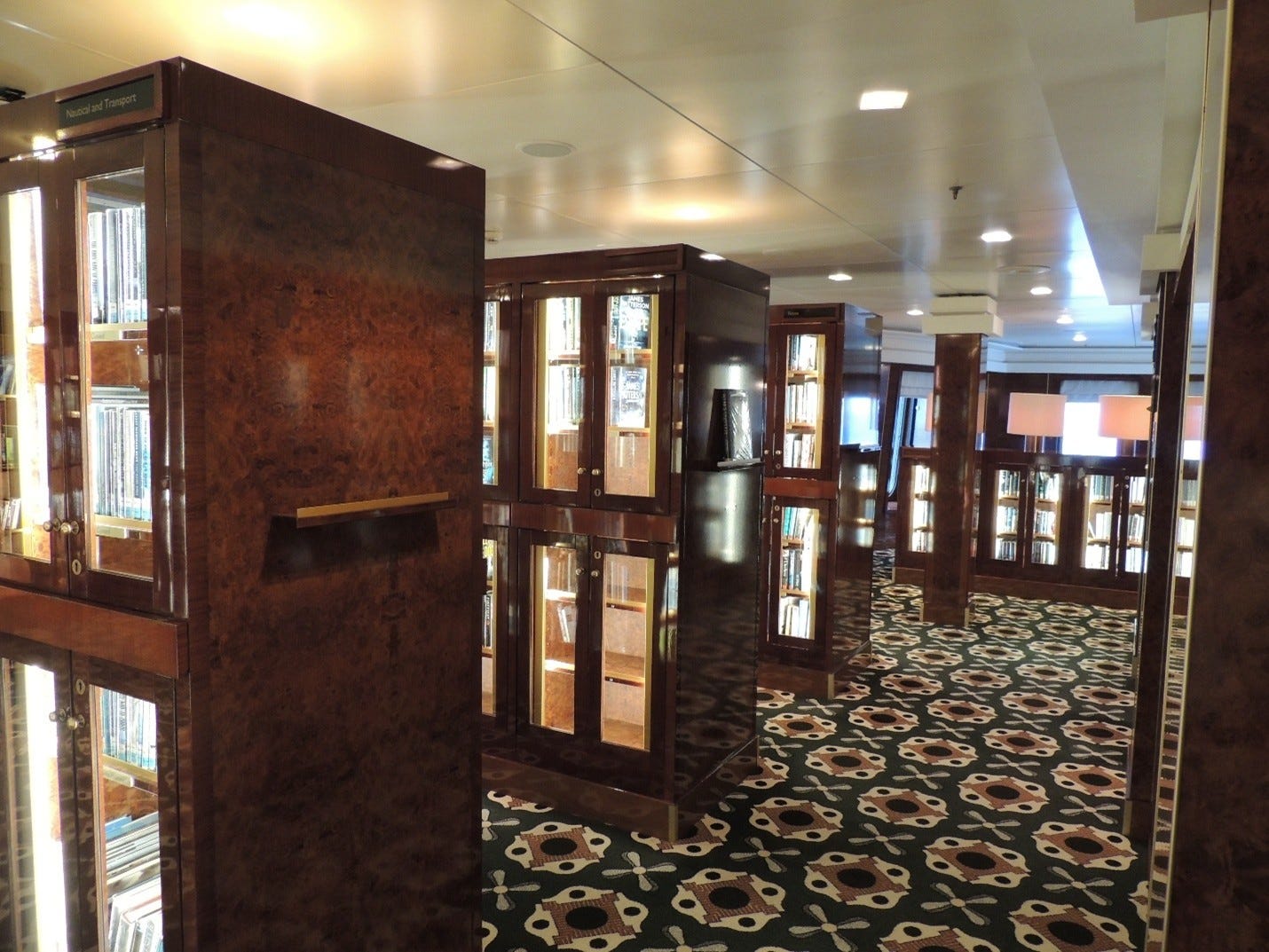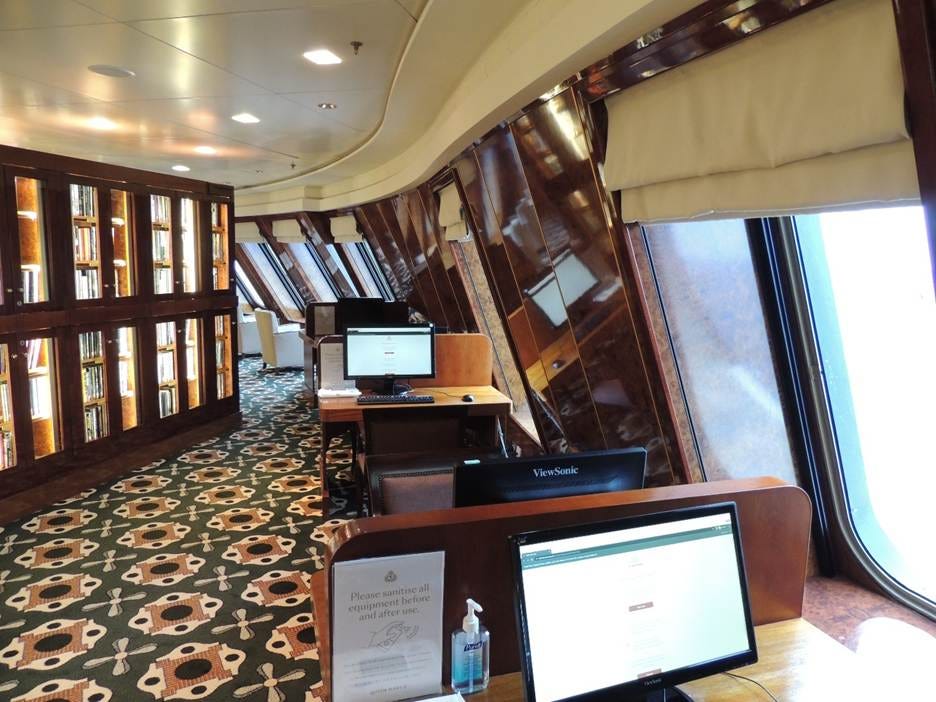The Trip Home on QM2
The Atlantic Crossing East to West, and Final Reflections
The way back home went through Paris. Why, you ask? Because for my regular travels, all I needed were a couple of shorts, a handful of polo shirts, and underwear. For the transatlantic cruises, however, I had to bring a whole other wardrobe - “smart casual” for the Prima and not only “smart attire” for the Queen Mary 2, but “eveningwear” for the Gala Evenings (there were two for the week-long crossing from London (Southampton) to NYC (Brooklyn). For extra points, one could “embellish their Gala Evening attire to fit the applicable theme of the evening.” For the first Gala, the theme was “Black and White”; for the second, Masquerade. I did not go so far as to bring a tux (although I do have one), but I did procure a Venetian-style mask:
Mysterious, am I not? 🤓 In the end, I didn’t get a chance to wear it; but I am getting ahead of myself.
The additional “attire” (with appropriate shoes) required a whole other suitcase. Now, there was no way I was going to schlepp through Europe with two suitcases. Last year, faced with a similar predicament, I mailed my second suitcase back home (I regaled my readers with my adventures in doing so at https://jonathanblake.substack.com/p/discovering-lisbon).
This year, the situation was more complicated – I was doing transatlantic crossings on both ends! Plus, I was going to have dinner at a ritzy restaurant in Paris. Luckily, other folks encounter similar situations, and there are companies that rent lockers in major cities to help them out. In Paris, it was City Locker Paris, conveniently located between the two railway stations I would be using: Gare du Nord and Gare de l'Est. For the 15 days, they charged me a bit over 200 Euro (around $230). Steep, but what other choice did I have?
So, I had to return to Paris before continuing on to London and Queen Mary 2.
My original plan was to use my Eurail pass and take a train from Prague to Paris. Seems simple enough, no? Well, in real life, Eurail has to work with 30 independent rail companies, and none of them, apparently, offer a direct connection between these two major cities. The best option I found involved three trains, departing Prague at 3 a.m. and arriving in Paris just after 5 p.m. I did reserve (and paid for) the seats, but I was feeling increasingly uneasy about it. I had to get to London that day to ensure I would make my cruise the following morning, and I didn’t feel like I could take a chance on successfully making all the connections.
So I abandoned my plans (and tickets) and booked a Ryanair flight that got to Paris a little before 8 a.m. Of course, it didn’t really arrive in Paris, but in a (relatively) nearby airport, Beauvais (a familiar name – I’d been there many years ago on a work trip). Fortunately, there was a well-oiled transfer process to the middle of the city (Saint-Denis University) on buses that seemed to be arriving continuously. The ride lasted only a little over an hour.
Having reclaimed my “cruise suitcase,” I took the Eurostar to London without incident.
Once in London, I stayed in a reasonably priced hotel just minutes from St. Pancras International, the Eurostar terminal, where I would catch the Cunard shuttle to the ship. Of course, being economical, the hotel was also quite “cozy”: I had a bit of trouble moving around the room with both my suitcases occupying, seemingly, all the open space. But the front desk folks were lovely, the room was clean, the shower worked, and it was located on a quiet residential street close to a bunch of restaurants.
St. Pancras is quite a striking building:
, across the street from the King’s Cross station. Being that close, I couldn’t resist looking for the famed Platform Nine and Three-quarters. It is indeed a destination on Google Maps! After meandering through the station for a little while, I finally saw it. Naturally, it had a huge line in front of it, and the glacial speed at which the line moved prohibited my direct participation. I had to settle for taking a picture of someone else attempting to walk through the wall:
From the shuttle bus (provided by Cunard at an additional charge), we caught the first glance of our ship:
I got a full-length picture after we got a little closer:
It is a looooong ship! And definitely narrower than other ships carrying 3,000 or more passengers. Someone explained to me later that ocean liners are built for speed and stability, and are longer and narrower than cruise ships, which tend to be broader and taller. Cruise ships usually operate in shallower, calmer waters while ocean liners can easily brave the vagaries of transatlantic and transpacific travel. Cunard is the last of its kind: with the QM2 sailing regularly between London and New York, it uniquely preserves the tradition of scheduled ocean liner travel.
I chose an inside cabin for this voyage because (a) I’ve never tried it before, and (b) it was only a week; how claustrophobic could it get? The answer was: plenty.
Here was my cabin:
It was somewhat akin to my “cozy” room in London, although a lot more posh
and with room service (free for breakfast).
I ordered breakfast every day, mainly for access to coffee. I’m sure I had commented before on how irritating it was for me not to be able to get an American-sized coffee in Europe. Well, for breakfast, they delivered coffee in a carafe that held at least 16 ounces – the size of my coffee mug at home. At last! I could drink my fill.
You see that TV? The ship’s programming offered a few news channels and several movie channels, all in multiple languages, as well as many Cunard channels. The “map” channel showed our location as we were crossing the ocean. Apparently, we followed in the wake of the Titanic, because the place where it sank was prominently featured on the map. Not only that, the captain talked about it at length during his noon-time update, noting the exact time we would be passing over the wreck. I admit, it was quite unnerving to be reminded of the most famous liner tragedy quite so conspicuously. Were they still gloating over the demise of their competitor? 🤨
I encountered an unusual amount of trouble with the ship’s layout. It was so long –
(This is looking aft from my room – and I was not even close to the front!)
– that it required three elevator banks. Walking back and forth wasn’t really a problem; it was all the hidden compartments and side staircases and passageways that I couldn’t get straight. In “normal” ships, because they’re wider, the restaurant is usually the last thing in the back, and the theater is the last in toward the front (or vice versa). Well, because the liner tapers from a shorter width, both the Britannia dining room
and the Royal Court theater
have other venues beyond them: the restaurant has the Queens Room, a dance hall, in the back of it, with yet another club (G32) behind it, and the theater has an Illuminations lecture hall closer to the front:
My problem was that this setup was not simply different; QM2 inserted half-decks to navigate around the large auditoriums to the smaller spaces behind them. To get around the theater, for example, you had to go to a whole new staircase, descend a single flight down, and go down this lovely but otherwise hidden passageway:
Additionally, on the starboard side, the route to navigate around the theater was different. (BTW, here’s an easy way to map “port” and “starboard” to more familiar left and right: both port and left have four letters; right and starboard don’t. Works for me!)
This … peculiarity caused me no end of trouble. Other oddities abounded as well. For example, the ship features an attraction called the “scenic elevator.” When I first saw it on the ship schematic, I was intrigued. The entrance to it, though, was inside an unmarked niche in some lounge; the exit (a few floors below) was in a featureless corridor.
It was an interesting ride for sure:
, but I don’t believe it got a lot of use.
The ship’s aesthetics are of a traditional luxury yacht: all gleaming wood and brass accents. There is a lot of nostalgic memorabilia: pictures of the royalty and famous guests who graced the original Queen Mary and its successor, and tributes to the line’s founders:
Sir Samuel’s lounge is “a quiet, elegant venue for enjoying specialty beverages, snacks, and dessert,” which is very nice; the trouble is, that can be said of every lounge on the ship (perhaps sans dessert).
All lounges are “quiet and elegant”:
The only difference was what sort of music was playing: a classical trio, a smooth jazz band, a duet singing old standards, a harpist, or a cocktail pianist.
Every night, the Queens Room featured a long evening of ballroom dancing, with a few couples typically dominating the floor in their competition costumes; the amateurs looked awkward by comparison. The “Galas” were held there, and only differed in costume. I didn’t bother going to either.
The Queens Room also hosted daily Afternoon Tea. It began with a parade of waiters carrying tea kettles in a regal display, followed by waitresses with trays laden with the typical afternoon tea fare: finger sandwiches, scones, and pastries. My daughter, who spent a week in England visiting a college friend a while back, admonished me to try scones with clotted cream. I obliged, and to me, that indeed was the highlight of the event.
I couldn’t help but compare it with the same meal I had on the Regent Splendor; there, I had a whole menu of teas to choose from, and every person was served a three-tiered tray laden with goodies. Try as I might to leave any, I couldn’t resist: they were all so good. On QM2, economy got the best of good intentions: the treats I tried were quite mediocre.
That tendency seemed to carry over to other areas as well. There were many repeat passengers on the ship, and at least the ones I talked to kept mentioning offerings and features that seemed to have been scaled back: room service was no longer free (after breakfast); water bottles in the cabin had to be bought; there was a reduced menu in the main restaurant; and many dishes that used to be included now required a substantial supplement.
I did enjoy the food and service at Britannia (the main restaurant) very much; everything was well-prepared and professionally served. I booked two dinners at specialty restaurants adjacent to the food court: Bamboo, which offered Asian Fusion, and Coriander, which served Indian cuisine.
The Asian dinner was superb; each course was marvelously prepared and presented.
The Indian restaurant, on the other hand, fell well below expectations. I’ve been to India many times and have been exposed to the full range of Indian cuisine – North, South, homemade, street food, and a wide variety of restaurants, from communal to gourmet; so I have a firm basis for comparison. This was bland and underwhelming. I may have just been unlucky – a lovely couple dining next to me said their Asian dinner was poor, but they were enjoying the Indian one.
The most enjoyable meal for me was actually a “lunch and learn” experience – a four-course extravaganza with two different wine pairings for each course. My favorites were this seabass and asparagus concoction:
, and the lamb chops:
(Of course, after eight samples of wine, everything tasted pretty good 😉)
They had a different sommelier introduce each pairing, discussing the provenance, the terroir, the “notes,” and so on. It was certainly interesting, yet little matched my experience with the wines I tasted. I’m afraid I’m just not a wine connoisseur.
When first signing up for this cruise, I chose an early (6 pm) assigned seating in Britannia; I figured it would be nice to get to know some guests (the other option was dining by myself).
As it turned out, I started having dinner with a small group of solo travelers that included one of the lecturers at Illuminations and a few other interesting or amusing characters:
By the last night of the cruise, though, I decided to try out my assigned seat, to see what I’d been missing. Well, to my surprise, all my dinner companions (at a table of 10) turned out to be drop-ins who got seated there by chance on that day! I guess whatever the initial group was, it did not persist.
The entertainment was hit-or-miss; there were some great performances, and some I can’t even recall.
I especially liked Stephanie Webber, who was on the British version of The Voice and who did have a phenomenal voice and a sweet personality, and Joe Stilgoe, an absolutely amazing pianist, singer, and songwriter. He did two shows and, I suspect, by popular demand, a question-and-answer session.
He has an uncanny ability to take random songs called out by the audience and weave them together in a masterly way. He improvised an extremely complex series of jazz chords and passages in one of those stunners that left me absolutely speechless. He was brimming with melodies, anecdotes, and ideas – he reminded me in that way a little of Robin Williams, just a volcano of talent.
He was to do a show in New York the day after we arrived; I was sorry I couldn’t make it. One of our group who stayed in NYC for a couple of days did go to see him at Birdland; she said it was a straight jazz set, with no improv; I am sure it was still wonderful. This is the picture she took of him:
QM2 published a daily newsletter listing all the activities. There were the usual trivial pursuits, card games, and dancing classes; and a load of art auctions, merchandise demonstrations, and other activities designed to separate us from our money.
The most interesting for me were the lectures at the Illuminations auditorium. There were five series:
Linda Sage, a British criminal psychologist and author, talked about life behind bars, British serial killers, “women who kill,” and other fun subjects. She was part of my dining group. Stein Ringen, a Norwegian sociologist and political scientist, did a fascinating series about the historically accurate Vikings (surprise: we know much less than the popular movies and games would have us believe). Matthew Towler, a retired counter-espionage and cybersecurity expert (I suspect he must have been in MI5, although he never said so), talked about a variety of related topics (no surprise: nobody is safe from surveillance, anywhere, at any time). Luigi and Alison Bonomi, literary agents, explained how to submit fiction or non-fiction book ideas to agents and what makes a promising book (from a publisher’s perspective). Finally, there was a lady talking about Women in STEM; from the descriptions, it appeared to be ideologically loaded, and I was on holiday from all that, as the British say, so I skipped those.
Between all those, the dinners, and the shows, the days were full, and the week passed all too quickly.
My initial impressions of life aboard QM2 were not altogether favorable. As I mentioned earlier, the ship's design is remarkably confusing, with secret passageways leading to unmarked spaces and hidden features. I suppose some may find it fascinating to keep stumbling on new areas of the ship; to me, it was just baffling and frustrating.
I also did not appreciate the enforced formality of it. You can't show up in public areas without formal attire after 6; I felt like there was nowhere I could go in shorts at all (the weather was way too cold and windy to go out on deck or, especially, the pool). Oh, they say, you can go casual on a certain deck or into the buffet area, but I’d have to pass through the entire ship to get there, so what do I do, change after I get there?
Finally, the average passenger age was like 75. NCL Prima was no playground for sure, but this was ridiculous. Most of the lounges played music suitable for that set, and most of the activities were targeted at them also. For octogenarians who like to dress up and do the foxtrot under a tinkling chandelier, that was perfect; I didn’t feel like I was there yet.
In retrospect, that judgment seems too harsh. The ship’s aesthetics were superb; just look at these decorations:
The Library was the most impressive of any ship I had previously sailed on:
The Wi-Fi worked well throughout the ship, and most importantly, in my cabin.
I did find enjoyable company:
, and the guests in general were genteel and proper. I did notice a marked difference from the Prima: whereas on the Norwegian ship, almost everyone said “Hello” when passing each other in hallways, that was an exception, not the rule, on Cunard. Maybe because the mix of passengers was not as predominantly American? (I’ve read many accounts of Brits visiting America and being astonished at strangers saying “Hi” to each other in public places.)
The disembarking went flawlessly; I took the Cunard transfer to Penn Station, and that worked out very well.
Would I do it again? I answered that question on board. There was an opportunity to book an itinerary for next February that made my mouth water – a 23-day trip from Singapore to Sydney on Queen Anne. But I didn’t think I could take living under the same formal regime for three weeks, so I passed, even though the price was phenomenally good.
Final Reflections on the Trip
This was the second-longest trip I undertook, 48 days, almost seven weeks. Nine cities, almost as many countries. It was fabulous and very enjoyable – as you read in my Reflections. In the future, though, I think I’ll switch to longer stays at fewer places.
I spent a week in London, but London offers so much that it felt like a series of daily sprints through major attractions. I built in “rest days” during the eight days I spent in Prague, and I engaged in some non-touristy activities, but I still didn't feel like I had a true taste of local life; I think that only comes with time and immersing oneself in quotidian situations.
Luckily, there are still many places to visit on my “bucket list.” Let’s see what the future brings!






